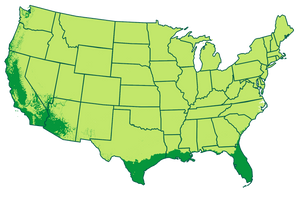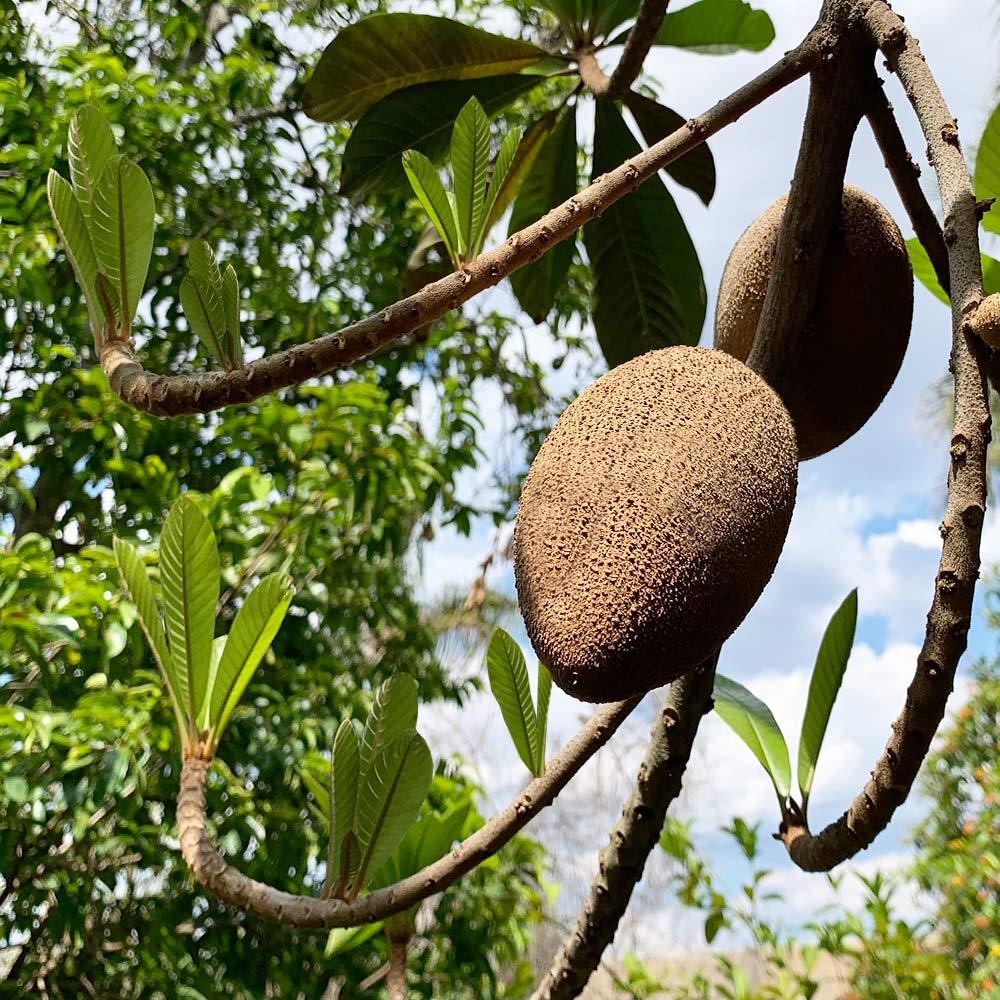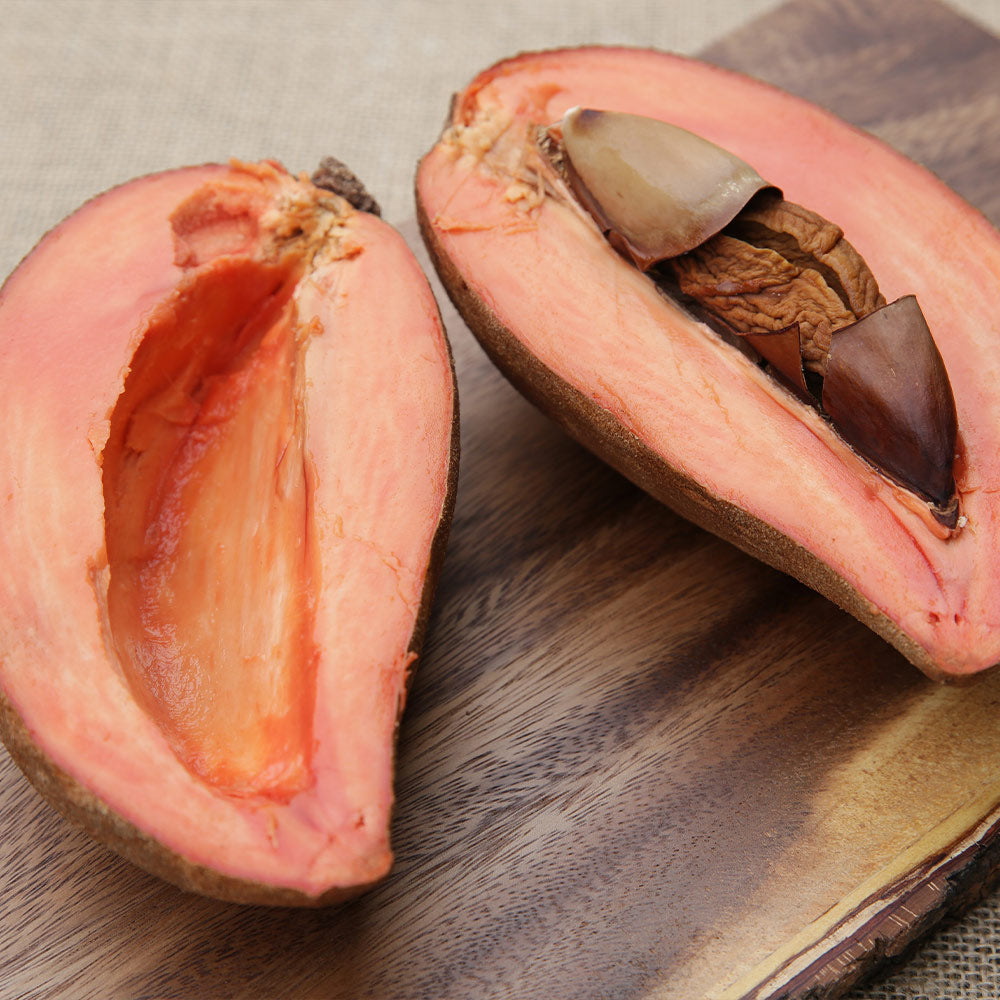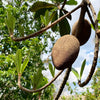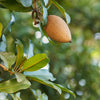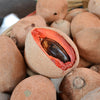* Images shown are of mature plants

Have questions? Talk with our Plant Experts (800) 973-8959
Fruits for 100 Years!
The Mamey Sapote fruit tree is the gift that keeps on giving. The mature mamey tree can bear between 200 and 500 HUGE berries per year. Plus, you can pass it down for generations, because it can live for a century. Producing fruit the whole time!
You’ll have plenty of mameys to share. You could even be planting a fruit tree now for your great, great grandkids to enjoy!
A Rare Tropical Fruit Will Grow in Your Yard
The Mamey Sapote is the national fruit of Cuba, but it’s still kind of rare in the US. It came to South Florida in the late 1800s with Cuban immigrants. Some groves have been established in Florida, Texas, California, and Hawaii. But they are still few and far between.
You can make a statement by planting this tree in your yard: You’re not afraid to take chances and try something new.
Plus, you’ll be working to cultivate an endangered species in the US. Many mamey trees have been lost to hurricanes and commercial fruit growers are working hard to reestablish better growth.
Be a part of the solution by planting one in your yard.
Attractive, Sturdy Tree for You
This Cuban fruit tree reminds many people of a southern favorite—the Magnolia tree. Because of its shape and leaves. It has a strong trunk that spreads widely with thick branches. The ends of the branches are covered in large, lush green, obovate leaves. In the spring, mamey is covered in clusters of small white or yellow flowers that have a sweet aroma.
In May, the flowers give way to the fruit. The mamey is a bountiful tree that bears fruit through September.
Have the beauty of a Magnolia with the satisfaction of the sweet-tasting mamey fruit.
Biggest, Most Unusual Berry You’ll Ever See
A single mamey berry is 9 inches long and the shape of a football. Each fruit weighs between 1 and 5 pounds. Making it one huge berry!
The skin is russet brown and feels like sand paper. But when you open it, you’ll be delighted by the soft salmon-colored flesh.
You wouldn’t expect it to be a berry because of the hard thick outer layer and the sweet melon-like flesh. This is nature’s little surprise that you shouldn’t miss out on experiencing for yourself.
Enjoy its Unique Flavor
The mamey is sweet and creamy with a smooth yet finely granular texture. It tastes like pumpkin combined with chocolate, honey, almond, and vanilla. All the delicious things—in one bite!
Check for ripeness by scratching the surface. If it’s green, it’s not ready. If it’s pink, pick it and let it ripen for a few days. When it’s soft, it’s ready to eat.
It can be eaten raw, in a salad or a smoothie, or cooked in savory dishes. In Cuba, they love to drink mamey milkshakes. Just blend mamey pulp, milk, ice, and sugar.
In South Florida, the milkshake is called Batidos. It’s very popular and hard to find.
Grow This Cuban Fruit Any Way You Want It
Mamey Sapote, also known as Mamey Colorado, is an adaptable tree that will grow well in any warm climate. As long as the temperature doesn’t drop below freezing, the mamey will thrive in sand, heavy clay, and limestone. It just needs lots of sunlight, well-drained soil, and regular watering.
You can also plant it in the ground or in a container. This versatile, attractive plant will look pretty as a focal tree in the front yard, a decorative potted plant on the patio, or a border tree at the edge of your property.
Enhance your space with this tropical delight by ordering it today!
Pollination Info
Mamey Fruit Tree Pollination
Mamey Fruit Trees are self-fertile. You will get fruit with only one plant. However, adding an additional Mamey Fruit Tree will drastically increase the size of your crop.
Planting & Care
Location: The Pouteria sapota is commonly called the Mamey Cuban fruit tree because it is the national fruit of Cuba. It grows into an exceptionally large tree that towers 40 feet when fully grown. It usually has a large central trunk and several huge limbs that give it an open appearance. In optimum growing conditions, the tree has been known to exceed 60 feet in height.
Keep in mind that Mameys are ideal for outdoor growing in zones 10 to 12 but can be potted up in zones 9 and below.
Avoid planting the mamey tree close to structures. Allow at least 30 feet of space between the tree and any building, fence or roadway. Plant the tree at least 20-30 feet from all other trees and structures to afford it adequate growth room.
Note: This product grows best in well-draining soil. When you receive your plant, you may notice small, white beads or rocks in the soil - this medium is added to increase drainage and keep your plant happy and healthy!
Planting Instructions: Plant the mamey in a location that receives 8+ hours of sunlight per day. If the tree does not absorb sufficient sunlight it will not produce an ample crop of fruit.
The mamey tree will grow well in a wide variety of soil conditions and pH levels but will not tolerate wet roots. When the tree’s roots are exposed to excessively moist soil conditions for an extended time the roots quickly begin to rot.
Dig a hole that is 3-4 times the diameter of the mamey tree’s root ball and 3 times as deep. Most soil in tropical regions contains an abundance of sand, If the soil is overly sandy, mix the sandy soil with fertile garden soil at a ratio of 25 percent sandy soil with 75 percent garden soil or amend some peat into the native soil to retain moisture.. Place the soil/sand mixture around the tree’s root system and tamp to remove all air pockets. Mound the soil slightly around the tree’s trunk so it is about three to four inches higher than the surrounding ground level.
In areas where the water table is not sufficiently deep, the mamey tree might need to be planted on a five-foot mound of soil to prevent the tree’s roots from becoming submerged in water as the tree grows.
Staking: In areas that sustain high winds or tropical storms, stake the tree using a bamboo or wooden stake. Tie the tree to the stake using cotton or natural fiber rope so it does not damage the tree’s trunk. Check the rope every month to make sure it is not too tight on the tree’s trunk. Staking is typically only necessary for about 8 months to 1 year. To determine if your tree is ready to stand on its own, shake the middle of the tree. Providing there is zero movement from the base, the tree is ready to stand on its own. Leaving stakes on a tree for too long can be damaging, they will come to rely on these stakes for continuous support.
Watering: Water the mamey tree once every other day if the weather is warm and there is no rainfall. Keep the soil moist but not overly wet, mulching can be very beneficial in maintaining soil moisture. Be sure to keep a steady supply of water going to the tree during flowering and fruit set/development.
Fertilizing: Feed the mamey tree in March, July and September for the first three years using a 8-3-9 fertilizer formula. Follow the directions on the fertilizer’s label for application ratios. After the tree reaches four years of age, it usually does not require fertilizing to thrive.
In areas with calcareous soil, a foliar spray containing zinc and manganese should be applied every six weeks from March to September.
Pruning: When the mamey tree is young, it can be pruned to encourage three or four limbs to grow strong. Any damaged limbs should also be removed. Prune after fruit is harvested.
Pests and Diseases: The mamey tree is relatively disease and pest free.
Injury: The trunk of the mamey tree is highly susceptible to injury from lawnmowers and other gardening equipment. Great care should be taken not to damage the tree’s trunk or the tree may perish.
Shipping Details
Estimated Shipping Time: Most orders ship immediately. As noted on the website, some items are seasonal, and may only ship in spring or fall. Once your order is shipped, you'll receive an email with a tracking number.
| Amount of Order | Shipping Charge |
|---|---|
| Less than $49 | $19.95 |
| $49 + | FREE SHIPPING! |
Product Details
| Mature Height: | 25 ft. |
| Mature Width: | 25 ft. |
| Sunlight: | Full Sun |
| Growth Rate: | Moderate Growing |
| Harvest Time: | May-September |
| Botanical Name: | Pouteria sapota |
| Does Not Ship To: | AK, AZ, HI |
| Grows Well In Zones: | 3-11 patio / 9-11 outdoors |
| Your Growing Zone: | # |
